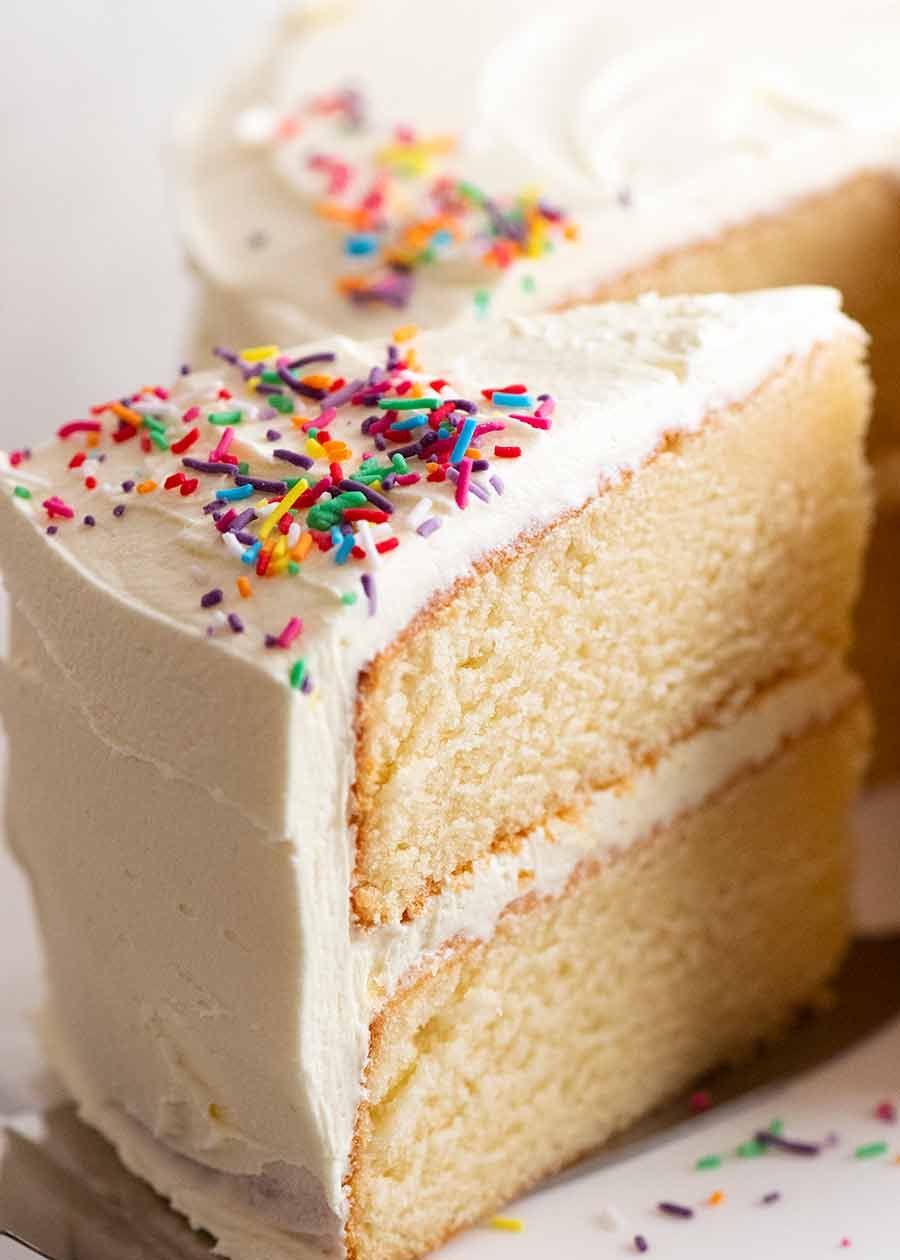
This is my best vanilla cake recipe. Soft and plush with a beautiful vanilla flavour and stays perfectly fresh for 4 whole days! It brings together fluffiness of Japanese cotton cakes with butteriness of Western butter cakes, plus an age old bakers’ trick for extra moistness to create the ultimate, classic sponge cake.
Fluffier, more tender and less greasy than the typical yellow cakes, much more moist than traditional sponge cakes. And it’s safer to make too!

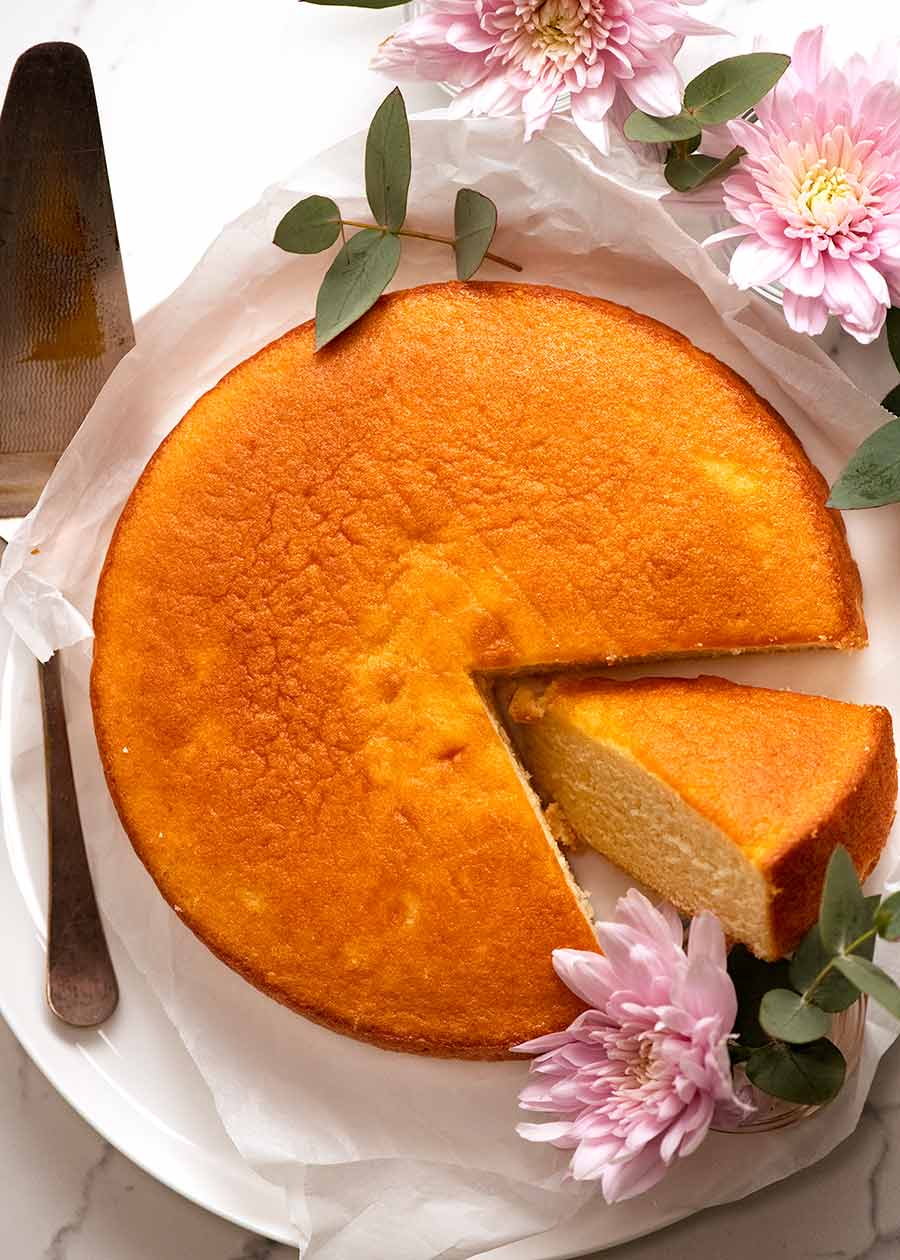
My best Vanilla Cake recipe
It’s taken me over 5 years to publicly share my best Vanilla Cake recipe because it’s taken that long to be sure that I truly do think it’s the best. Here’s why this is the perfect vanilla cake to me:
- Plush, moist, fluffy crumb without being freakishly unnatural (as some store bought can be). Forget dry, dense, rough!
- Keeps near perfectly for 3 whole days. 100% fresh on Day 1, still 96% perfect on Day 3. Unheard of for typical butter cakes!
- Lovely vanilla and butter flavour without a greasy mouthfeel or touch;
- Even, elegant crumb – no large tunnels or irregular, crumbly holes;
- Bakes perfectly flat – no levelling required!
- Not overly sweet; and
- Fluffiest cake possible for frosted layer cake or piles of cream and berries. In contrast, Chiffon Cakes and Japanese Sponges which are even lighter cannot hold up to much extra weight – the bottom layer gets quite squished.
So if all that appeals to you too, then I dare say this might become YOUR favourite vanilla cake recipe too! And here’s a little preview to show you how soft and fluffy it still is after 4 days:
Freshness preview – this cake is 4 days old!
Origins of this vanilla cake
This vanilla cake is the result of bringing together the best of Japanese sponge cakes and Western butter based cakes. It uses the making method and has the very soft, fluffy crumb of Japanese cakes, with the buttery goodness and sweetness of Western cakes. It’s also more sturdy than Japanese cakes which can really only be decorated with cream – anything heavier and the bottom layer gets squished!
Also, importantly, this cake incorporates my cake shelf-life requirement to stay fresh for at least 2 days after it’s made. Because who bakes cakes on the day they are intended to be served??
Interestingly, baking experts will recognise the method and ingredients in this cake to be very similar to what is called a Hot Milk Cake in America – albeit strangely it’s often described as a “dense” cake, presumably because they don’t preserve the egg aeration as well as I insist we do and also because sometimes it’s baked in bundt pans which takes far longer to bake.
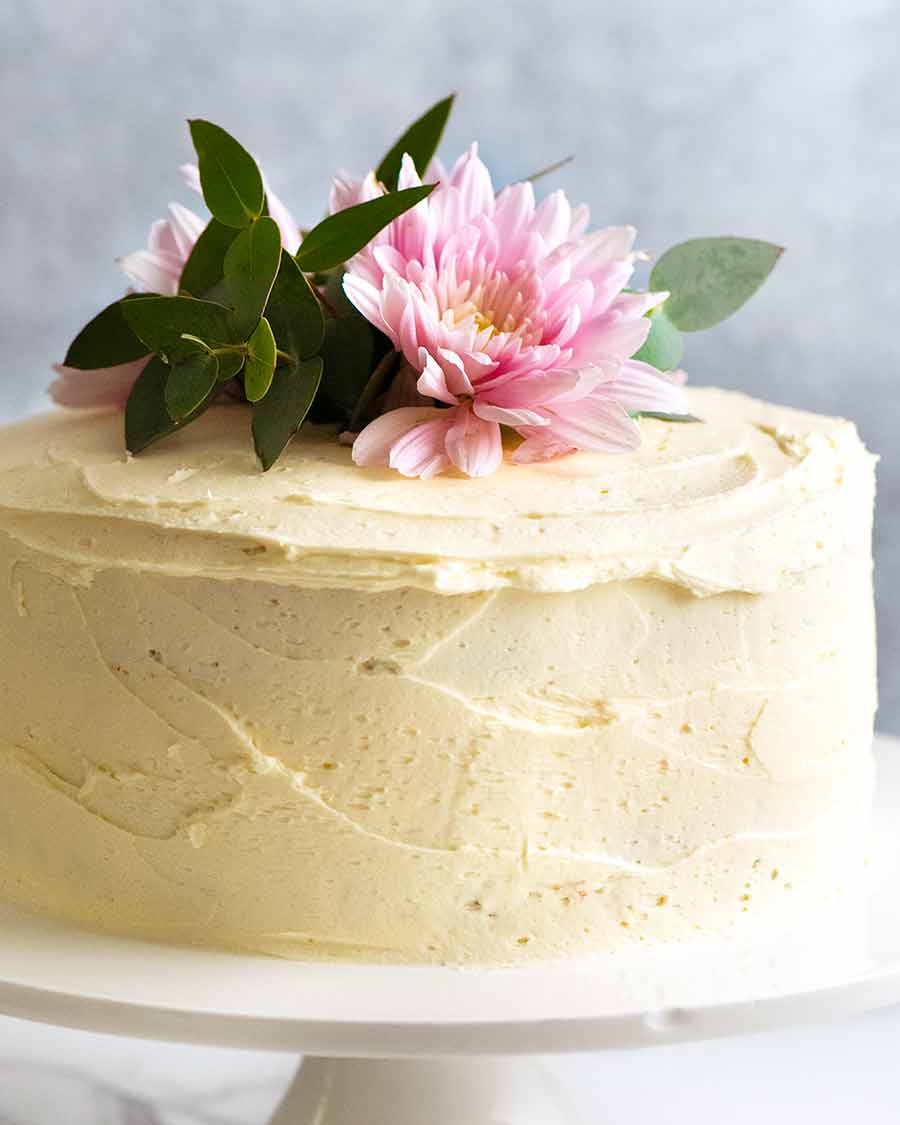
The words “best served on the day” on a cake recipe is never a good sign – it means it drastically degrades overnight. But THIS cake recipe is near perfect for 4 days – even 5 days!
I don’t want to get too cake nerdy with you… but one sign of a well made cake is an even crumb. No large tunnels or lots of irregular size holes. It looks and tastes velvety – a similar plush texture to Red Velvet Cake.
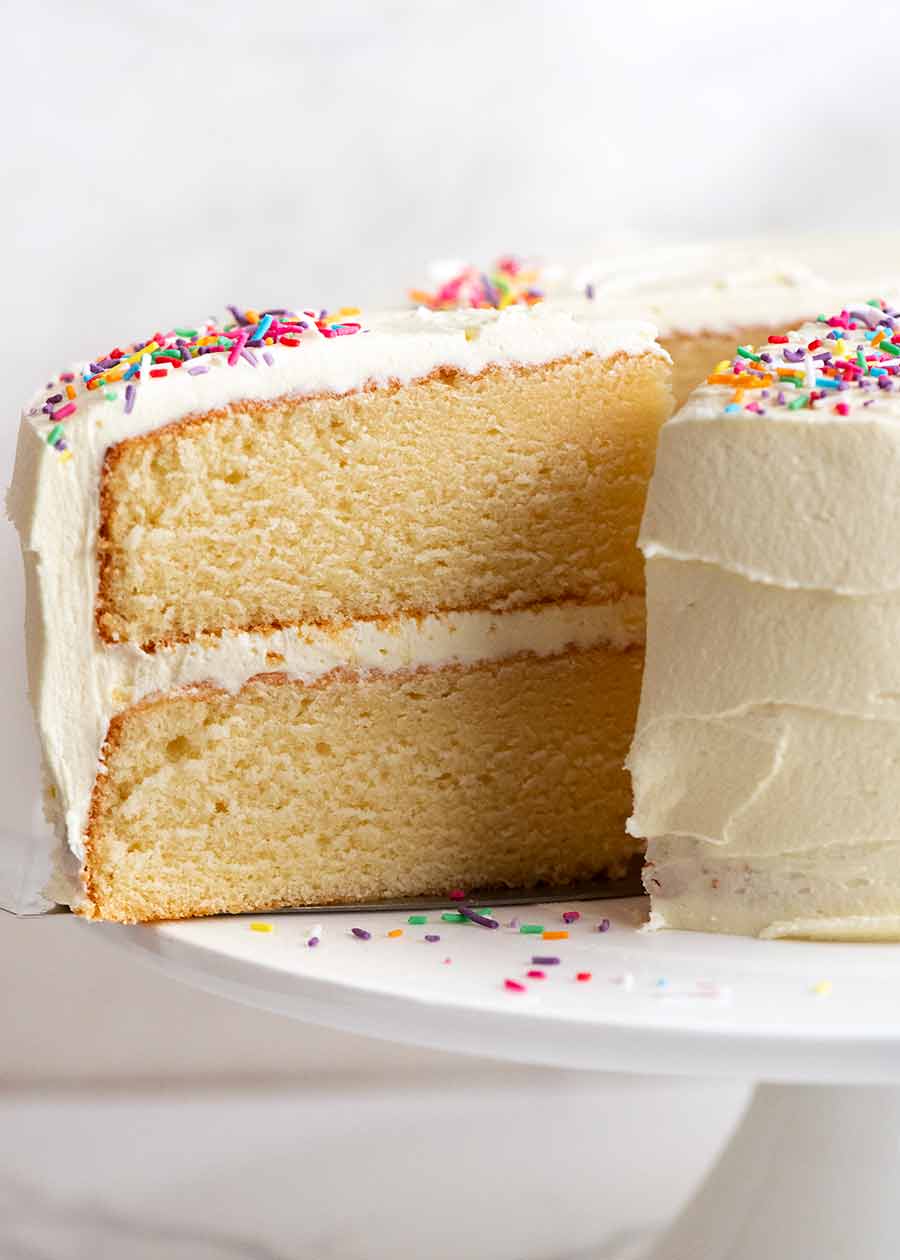
There’s a widely held misconception that cake flour is the secret to a better cake. That’s only true for certain cakes. For this one, plain / all purpose flour yields better results.
Ingredients in my Best Vanilla Cake recipe
Here’s what you need to make this plush, soft vanilla cake. No cake flour, no buttermilk, no sour cream. Tried them all – this cake is (much!) better with plain / all purpose flour and just milk.
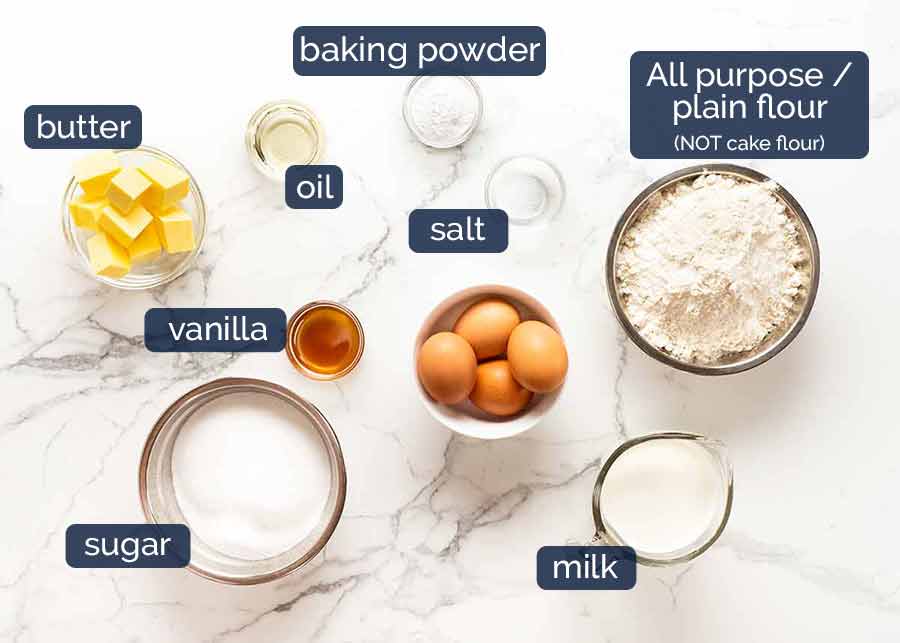
- Plain flour / all purpose flour – compared to cake flour, the flavour of the butter and vanilla comes through better, the crumb is slightly more velvety AND it keeps slightly more moist too. Bonus: no need to hunt down / pay a premium for cake flour! Do not substitute with self raising flour or gluten free flour.
- Eggs – whipped to aerate, these are key to make the cake extraordinarily light and fluffy. You don’t get an eggy flavour;
- Baking powder – not baking soda / bi-carb, it doesn’t rise as well. This is our safety net / helping hand to make the cake rise.
- Milk, full fat – just plain cow milk. Low fat works as well but rises marginally less. Do not substitute with non dairy milk or buttermilk;
- Sugar – best to use caster sugar / superfine if you can because it dissolves better in the eggs. But regular / granulated sugar works just fine too – you may just end up with some little brown spots on the base;
- Oil – just 1 tablespoon adds a noticeable hint of extra moistness, especially on Day 4, without weighing down the cake in the slightest. Don’t be tempted to add more – I tried an extra tablespoon and it didn’t rise as well;
- Vanilla extract – the best you can afford. Imitation will work just fine, but the flavour isn’t as pure or real. I use Queen Vanilla Extract. Don’t waste your money on vanilla beans or vanilla bean paste – it’s not worth it for cakes.
Why this is safer than typical butter cakes
The reason I tell people this is easier to make than typical butter cakes is because making a really good cake that starts with “cream butter and sugar until fluffy….” is actually harder than you think. The butter has to be at the perfect temperature, and you can’t have chilly mixing bowls.
If the butter is too soft, the cake will be greasy and dense – sound familiar? If it’s too hard, you’ll never manage to cream it and you’ll end up with grease pockets.
And even if you nail it, the cake rapidly loses freshness. Even the next day it’s noticeably drier.
How to make my best Vanilla Cake
A stand mixer makes this vanilla cake a breeze to make! While it takes time to beat the eggs to make a lovely fluffy cake, this recipe is more fail-proof than the usual “cream butter and sugar until fluffy” recipes – read the above box for why.
The unique plush, fluffy crumb of this cake is from double lifting powder – whipped eggs PLUS baking powder. No recipe that starts with “cream butter and sugar” will ever come close!
1. Whip the eggs and sugar – Beat the eggs with sugar for a whole 7 minutes until thick and glossy, and tripled in volume. The aeration created during this step is key for a soft, fluffy crumb. After this step, keep beating to a minimum otherwise you’ll knock the air out. Just follow my time and beater speeds and you can’t go wrong!

Here’s what it looks like before and after beating:
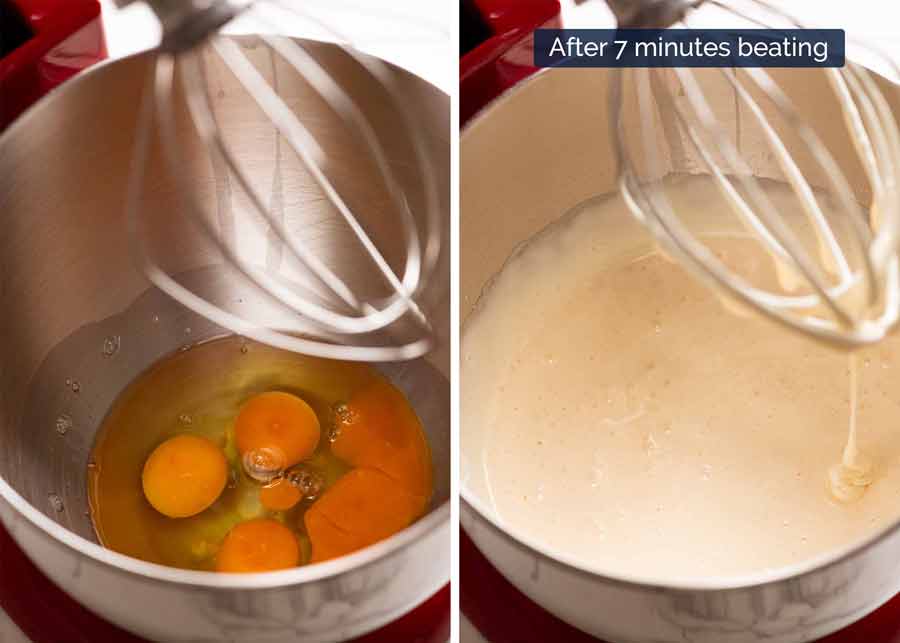
2. Gradually add flour – Add flour in 3 lots, mixing for just 5 seconds on Speed 1 in between. This should make the flour just incorporated – don’t worry if there are some bits not mixed in;

The melted butter in hot milk infuses this cake with beautiful subtle buttery flavour without the greasy mouthfeel inherent with butter cakes.
3. Hot melted butter in milk – use a microwave or stove to heat milk with the butter until it melts. Believe it or not, HOT milk helps with aeration in this cake. I doubted it, so I tried with cooled melted butter in milk. Didn’t rise as well!
4. Mix some batter into hot milk – this serves two purposes: a) bring down the temperature of the hot milk so it won’t “cook” the eggs; and b) it makes the hot milk lighter (see below – it biomes foamy) so it blends together faster when added to the rest of the whipped egg mixture. Remember, minimal beating is key so we don’t knock out all the cake-rising-bubbles we created in Step 1;
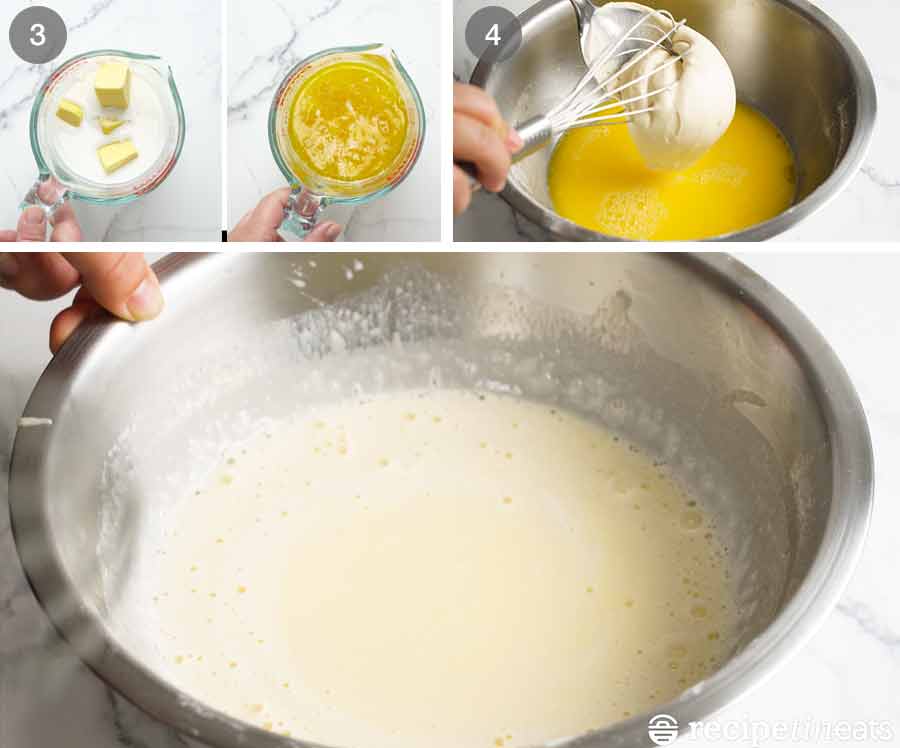
5. Slowly pour milk mixture back into whipped eggs over 20 seconds on speed 1. Scrape down sides of bowls, then mix for 10 seconds on Speed 1 – the batter should now be smooth;
6. Pour into 2 cake pans lined with parchment/baking paper;

7. {Optional} Knock out big bubbles by dropping the cake pans on the counter 3 times. This won’t affect the cake-rising bubbles created in Step 1. But it makes large bubbles in the batter rise to the surface and burst. If you don’t do this, you end up with maybe 10 or so large bubbles on the cake surface that go brown. It really doesn’t matter if you are frosting. But if you’re not frosting the cake (eg just dusting with icing sugar / powdered sugar), you may care;
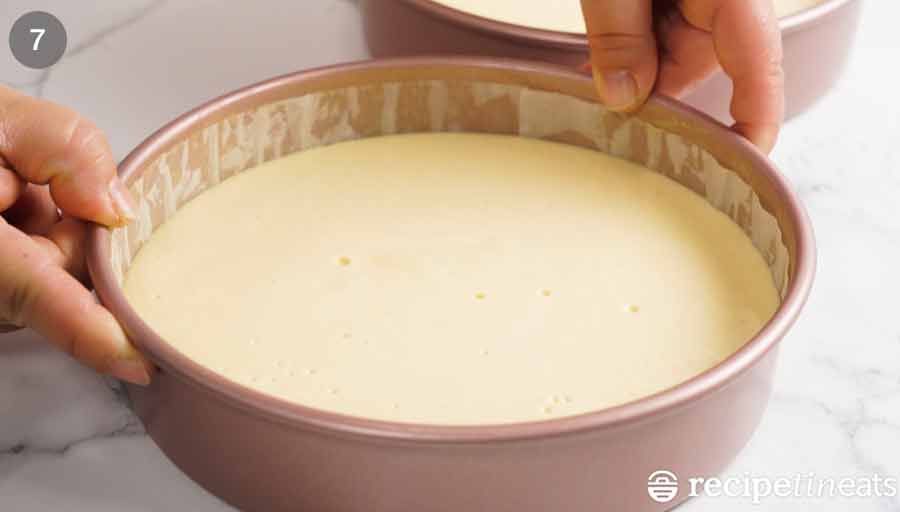
8. Bake 30 minutes until golden brown and a toothpick inserted into the middle comes out clean. The cake will have a slight dome but it flattens when it cools;

9. COOL upside down for level cakes (so you have neat, straight layers in a layer cake) on a cooling rack. If you don’t mind a dome surface / specifically want to show the beautiful golden brown surface (eg if making a cake dusted with icing sugar / powdered sugar, or a glaze), then cool it right side up; and
10. Decorate! Frost with your favourite frosting, smother with cream, fresh berries, swirl with chocolate fudge frosting or simply dust with icing sugar and serve with a dollop of yogurt or cream!

Day 4 – still super moist and fresh!
The photos below are my attempt to show you how incredible soft the cake still is four days after it’s made! If it were dry, the crumb would break when I jabbed it, and it would never spring back!
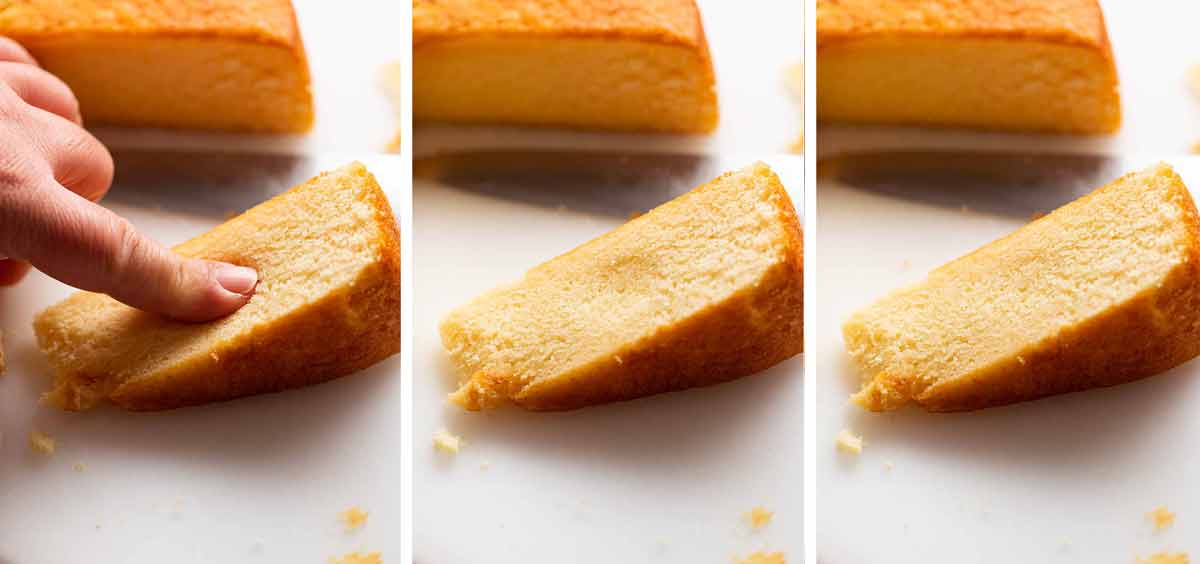
Tips to ensure Vanilla Cake success
You’ll love that this list is a lot less stern than many other cake recipes!
- Eggs at room temperature – these will fluff better and faster. Easy to warm up fridge cold eggs – just leave in warm water for 5 minutes. What’s a room temperature egg? Pick up the egg. Fridge cold? Too cold. Cool but not cold? That’s ok. Very warm? I would be worried they might be off! (Note: fridge cold eggs will still fluff just fine, but it takes a couple of minutes longer. Just more consistent results with room temp eggs);
- De-chill icy cold mixing bowls – run them under warm tap water then dry before using. Not hot tap water – just warm. Useful general baking tip – eg if you cream small quantities of softened butter in an icy cold bowl, the bowl can make the butter solidify. Common problem in houses without good heating throughout;
- Make sure the milk and butter are hot when you mix in the batter. I don’t understand the science, all I know is that when I melted the butter in the milk first then let it cool to lukewarm while I faffed around getting everything else ready, the cake didn’t rise as well;
- Cake pan WITHOUT loose base is best – the batter is quite thin so it can leak a bit if using springform pan or loose base sandwich pans. Not much, but a bit. You can prevent this by greasing the base extra well and “plugging” the gap with butter; and
- Recipe can be halved for one single layer cake, but do not bake all batter in one cake pan – it won’t rise as well.
Different cake pan sizes and bake times
This Vanilla cake will work with the following cake pan sizes:
- 2 x 20cm / 8″ cake pan – my base recipe (I like the cake height, slightly tall), 30 minutes
- 2 x 23 cm / 9″ cake pans – 27 minutes (good option for larger groups)
- Halve the recipe for a single round cake
- 12 cup tube pan or bundt pan (grease & dust with flour) – bake 1 hour, but note cake is not as fluffy as pictured and described. Still soft, but it’s slightly more dense (still delicious and thoroughly enjoyable, just different to intended)
- 23 x 33 cm / 13 x 9″ rectangle pan – 30 minutes (large single layer sheet cake)
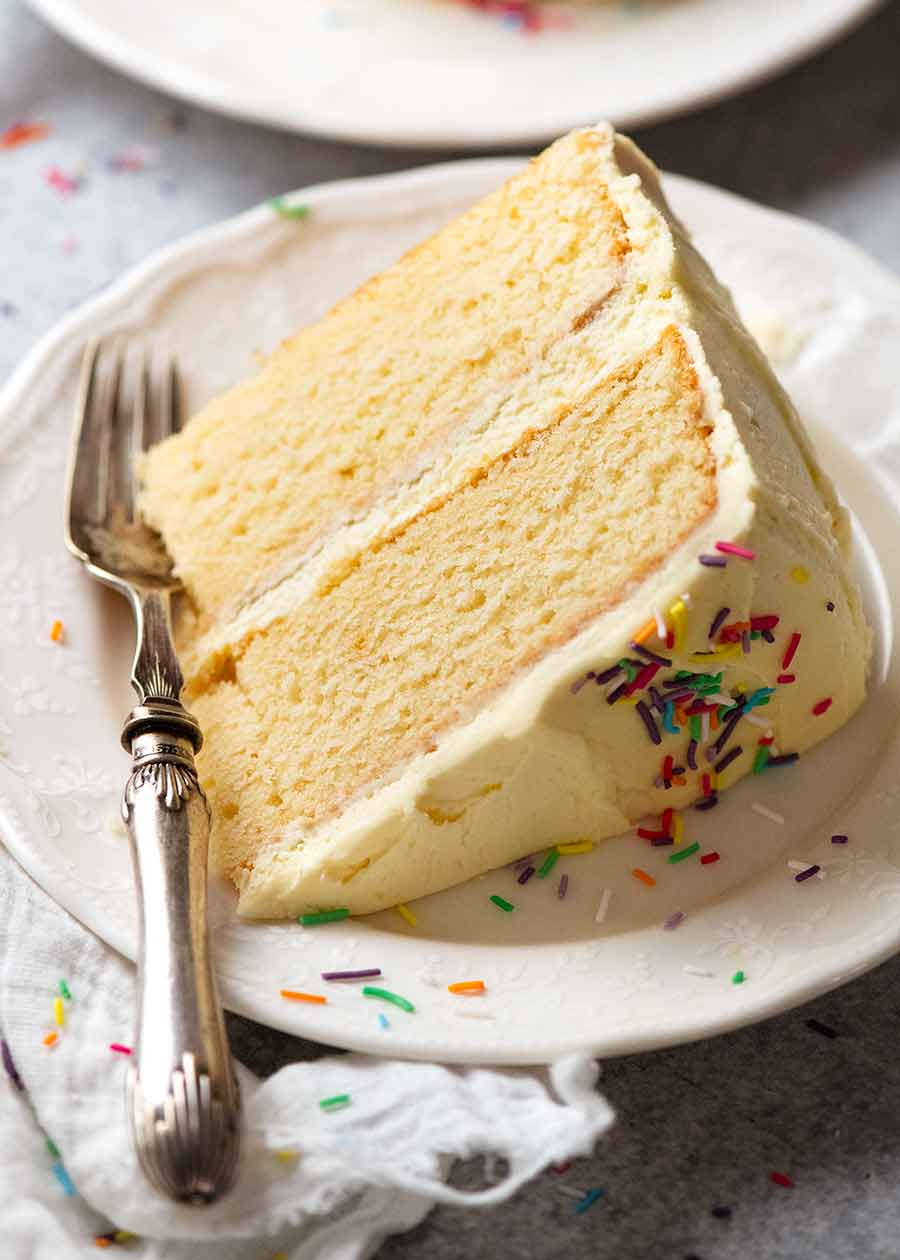
Ideas for frosting and decorating Vanilla Cake
Here are a few ideas for finishing this Vanilla Cake.
- Vanilla buttercream (pictured in this post) – the white on white(ish) looks pretty and of course, driving home the vanilla flavour;
- Sprinkles for an easy cheerful, birthday appropriate decorating option;
- Fresh flowers for an elegant option. Tip: Wrap the ends with a tiny bit of foil as a precaution before ticking it in the frosting or cream;
- Chocolate Buttercream for a classic Birthday Cake;
- Rich Chocolate Fudge – frost it with Chocolate Fudge Frosting made with melted chocolate. Double the frosting so you have enough for the inside, top and sides. Bonus: No electric beater required for this one!
- Jam and cream for Victoria Sponge – spread the upside base with strawberry jam, top with whipped cream. Please top sponge on then dust with icing sugar / powdered sugar. Note: this cake is a fluffier (and I dare say, better!) version of traditional Victoria sponge cakes which are actually very dense;
- Strawberry Shortcake – essentially, the Classic Japanese Shortcake but instead of using a Japanese sponge cake, using this Vanilla Cake instead. Read here for the difference between types of vanilla cakes;
- Glaze it with a semi-see-through glaze that drips elegantly down the sides, like the Lemon Glaze in this Lemon Yogurt Cake. Make it 2 x single layer cakes (or halve the recipe);
- PLAIN – do not underestimate the power of this cake. It’s so moist with such a lovely vanilla and buttery flavour, it is sensational eaten plain. Though if serving to company, I do think it’s nice to at least finish it with a dusting of icing sugar / powdered sugar, and perhaps add a dollop of cream on the side and a fresh strawberry (or two)!
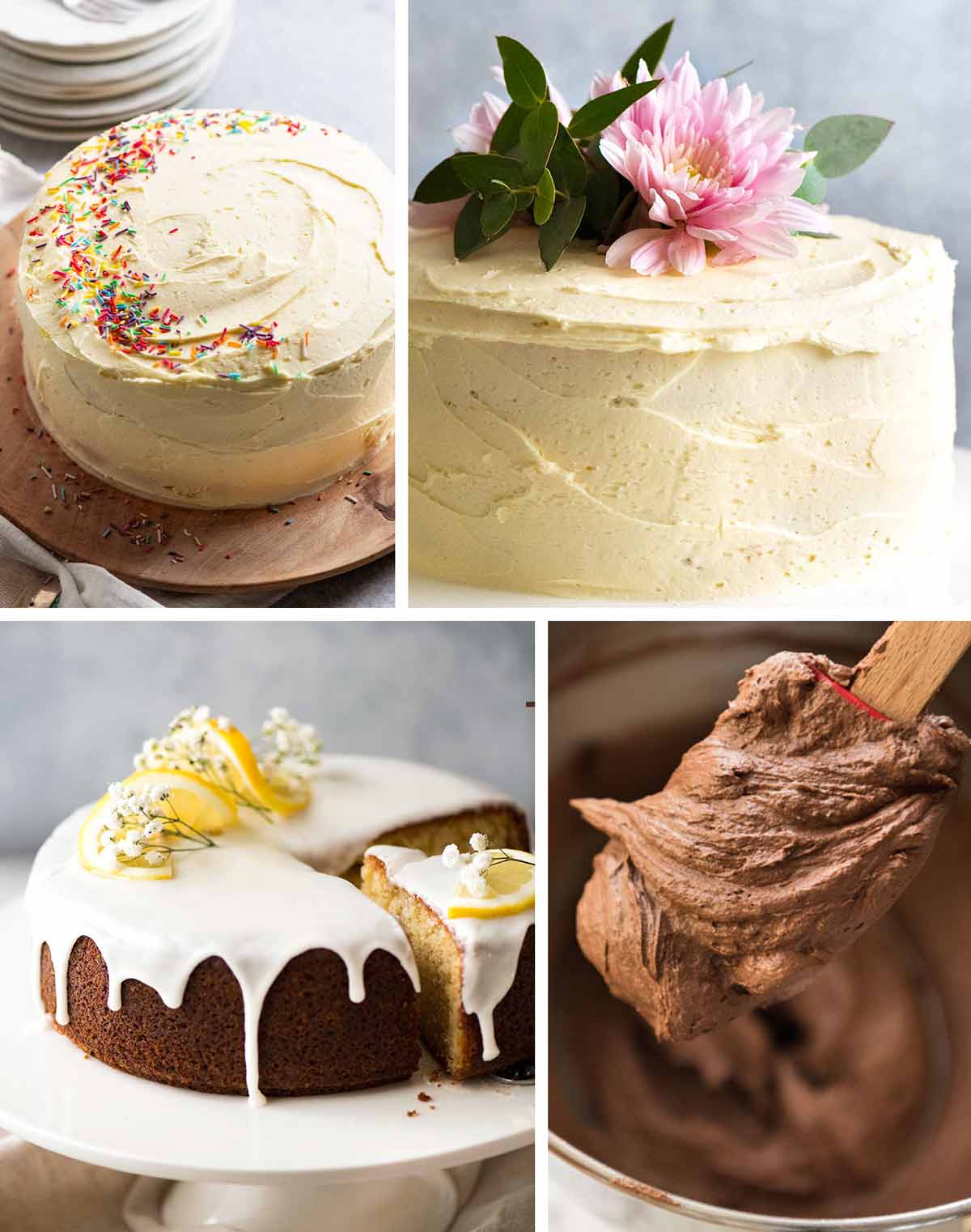
And with all that – I’m finally done. Finally happy. This is THE Vanilla Cake recipe that is my best all rounder. For birthday cakes, special occasions, to make to impress the pants off your family and friends.
And now it’s your turn. Tell me what you think! – Nagi x
Watch how to make it
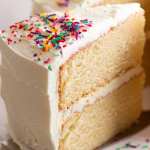
Vanilla Cake recipe
Ingredients
- 2 cups plain flour / all purpose flour , NOT cake flour (Note 1)
- 2 1/2 teaspoons baking powder (NOT baking soda, Note 2)
- 1/4 tsp salt
- 4 large eggs (50 - 55g / 2 oz each) , at room temp (Note 3)
- 1 1/2 cups caster sugar (superfine sugar) (granulated/regular ok too, Note 2)
- 115 g / 1/2 cup unsalted butter , cut into 1.5cm / 1/2” cubes (or so)
- 1 cup milk , full fat (Note 5)
- 3 tsp vanilla extract , the best you can afford (Note 6)
- 3 tsp vegetable or canola oil (Note 7)
Vanilla Buttercream
- 225g / 2 sticks unsalted butter , softened
- 500g / 1 lb soft icing sugar / powdered sugar , SIFTED
- 3 tsp vanilla extract
- 2 - 4 tbsp milk , to adjut thickeness
Instructions
Preparation:
-
Preheat oven to 180°C/350°F (160°C) for 20 minutes before starting the batter (Note 8). Place shelf in the middle of the oven.
-
Grease 2 x 20cm / 8” cake pans with butter (preferably without loose base), then line with parchment / baking paper. (Note 9)
-
Whisk flour, baking powder and salt in a large bowl.
Whip eggs until very fluffy:
-
Beat eggs for 30 seconds on speed 6 of a Stand Mixer fitted with a whisk attachment.
-
With the beater still going, pour the sugar in over 45 seconds.
-
Then beat for 7 minutes on speed 8, or until tripled in volume. (See note about hand beater)
-
Heat Milk-Butter: Meanwhile, place butter and milk in a heatproof jug and microwave 2 minutes on high to melt butter (or use stove). Do not let milk bubble and boil (foam ok). Don’t do this ahead and let the milk cool (affects rise).
-
Mix in Flour: When the egg is whipped, scatter 1/3 flour across surface, the beat on Speed 1 for 5 seconds. Add 1/3 flour again, then mix on Speed 1 for 5 seconds. Add remaining flour, then mix on Speed 1 for 5 seconds until the flour is just mixed in - once you can’t see flour, stop straight away.
-
Lighten hot milk with some Egg Batter: Pour hot milk-butter into the empty flour bowl. Add about 1 1/2 cups (2 ladles) of the Egg Batter into the Milk-Butter (don't need to be 100% accurate with amount). Use a whisk to mix in until smooth - you can be vigorous here. Will look foamy.
-
Slowly pour milk in: Turn beater back on Speed 1 then pour the Milk-Butter into the Egg Batter over 15 seconds.
-
Scrape and give batter final mix: Turn beater off, scrape down sides and base. Beat on Speed 1 for 10 seconds - batter should now be smooth and pourable.
-
Bake 30 minutes: Pour into pans. Bake 30 minutes or until golden and toothpick inserted into centre comes out clean.
Cool & frost:
-
Remove from oven. Cool in cake pans for 15 minutes, then gently turn out onto cooling racks. If using as layer cakes, cool upside down - slight dome will flatten perfectly. Level cake = neat layers.
-
Frost with frosting of choice, or cream and fresh berries or jam. See list of ideas in post!
Vanilla Buttercream:
-
Beat butter with whisk attachment in stand mixer for 1 minute until creamy. Add icing sugar / powdered sugar in 3 lots, beating slowly (to avoid a powder storm) then once mostly incorporated, beat on high for a full 3 minutes until fluffy.
-
Add vanilla and milk, then beat for a further 30 seconds. Use milk to make it lovely and soft but still holds it's form (eg for piping). Use immediately. (If you make ahead, refrigerate then beat to re-fluff).
Notes
- 2 x 20cm / 8" - per base recipe, 30 minutes
- 2 x 23 cm / 9" cake pans - 27 minutes
- 12 cup tube pan or bundt pan (grease & dust with flour) - bake 1 hour, but note cake is not as fluffy as pictured and described
- 23 x 33 cm / 13 x 9" - 30 minutes
Nutrition
Life of Dozer
Dozer on the job (and doing it a little too well, as you will see.  )
)
The post My very best Vanilla Cake (stays moist 4 days!) appeared first on RecipeTin Eats.






0 comments:
Post a Comment